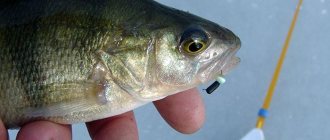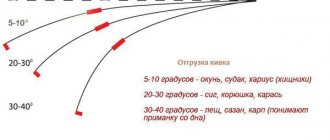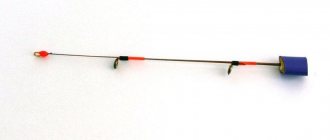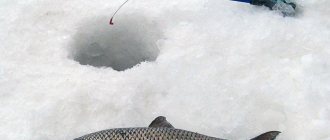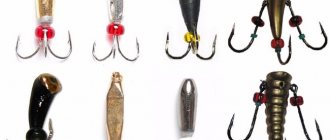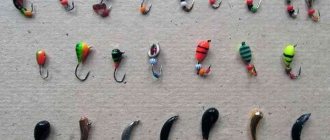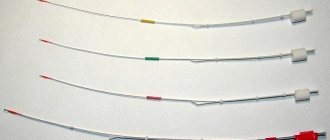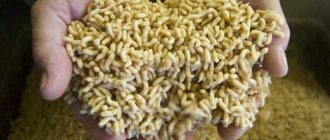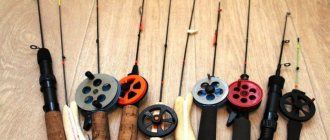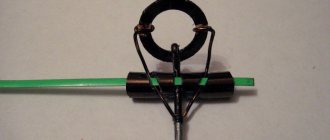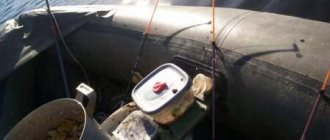At first glance, it may seem that its role in winter fishing is not particularly great. However, in fact, this piece of fishing equipment is quite important.
Its main functions are as follows:
- The most important point is that its variety and specific properties greatly influence the quality of the game when fishing. Since we are talking about reelless fishing, the specific type of game is one of the main factors that affects the success of fishing. As you know, playing a game and choosing the right nod is a very individual matter. Each fisherman chooses them based on his experience and knowledge. Therefore, the right choice is very important. After all, certain types of them create the greatest opportunities for very specific types of games.
- The second reason why it affects fishing success is that, in fact, it plays the role of a bite alarm. Therefore, its shape, degree of elasticity, material and structure are of particular importance.
- When fishing for caught fish, this part of the tackle is under heavy load. Therefore, its features significantly influence its implementation.
Types of nods
Let's talk about how many and what varieties there are for winter fishing. There are no universal gears. Therefore, this choice is based on the specific circumstances of the planned fishing.
Straight
As its name implies, here we are talking about a relatively rigid horizontal nod. In order to provide optimal conditions for catching certain fish, it is selected in such a way that the action of the bait (jigs or spinners, for example) is most consistent with what the fish like. Compared to a downward bend, in this case the frequency of nods will be slightly reduced.
Curved Down
The tip of the downward curved nod is usually in a straight line with the line. It is convenient for fishing at shallow and medium depths. This type of tackle ensures shallow and fast play. This will be especially effective when fishing in shallow water.
In this case, the tip moves forward and backward, and not down or up, as in other varieties. It is interesting that in such a situation the jig will not jump, but will only move slightly in the water column, attracting fish.
Curved up
As a rule, they are made of metal and are relatively rigid. Also, their length is much longer than in other cases. It can be fifteen or even twenty centimeters. Typically, this type of gear is designed for larger fish and for deeper fishing. On the other hand, with this design, this tackle is a good bite alarm.
Spring
This name means a slightly more complex gear arrangement. A special tongue is used here, which can extend to a certain length, imparting additional rigidity and at the same time changing the geometry of its bending under load (the bending is shifted to a greater extent towards the tip).
Overloaded
Overloaded is bent to such an extent that it is located almost vertically. It looks straight down, and not at an angle, like other types of such gear. It is used in cases where the amount of deflection is not particularly important. This happens when fishing at great depths or in strong currents.
Fishing in winter with a reelless bait
Reelless fishing is not as difficult as it might seem from the outside. You can master this type of winter fishing on the first try. You can successfully fish even with a motionless reelless bait hanging or lying on the bottom - a bait without a nozzle.
What is a rewinder
A reelless jig is... a simple jig without bait on a hook. More often, this hook is decorated with a pendant - cambric, thread, beads, wool... But for some reelless fish, decorations are not required at all - they catch just like that. The easiest-to-use jigs without attachments include devils, goats and bullies. It is with these baitless baits that you should begin to master winter fishing with a reelless bait.
Devil
The devil is considered a universal winter nozzle jig. We can say that he catches both predatory and peaceful fish in any body of water. The only thing is that the devil needs to be selected in size so that it is best suited for underwater inhabitants.
The classic one is the devil with a body shape in the form of an inverted drop, 8 - 10 mm long with a diameter of up to 4 mm. Medium perch, large roach and bream will not bypass such bait.
Smaller fish require a smaller reel. The sizes of soldered hooks can be in the range No. 20 - No. 14.
You can hear many fishing stories about how good it is to catch fish in winter using devils, about large piles of roach on the ice and about fishing boxes full of fish.
The simplest wiring with a devil is monotonous identical raising and lowering of this reelless thing. You can diversify by simultaneously shaking the fishing rod in the horizontal plane.
Which reelless devils do fish bite on?
As the size of the baitless jig decreases, the number of bites increases. But this happens mainly due to the fact that small specimens begin to peck. Catchable universal reelless baits are quite small, equipped with hooks No. 18 - No. 16.
Any fish can be caught with the devil; both pike and pike perch do not miss this bait. But mostly devils are used for catching roach and bream.
There is an opinion that bream like elongated devils with a diameter to length ratio of 1/10. These baits need to be played more slowly, and the bream bite itself looks like a slight holding of the bait.
Fishing with devil fish in winter is always effective
Goat
The goat has only two hooks, located relative to each other at angles of 60 - 120 degrees. The body, usually conical in shape with a slight bend towards the hook, is made of tungsten or lead, usually painted dark, weighing tenths of a gram. Small goats of about 0.3 grams with hooks No. 18 are considered the most catchy according to the typical inhabitants of our reservoirs - small perch, crucian carp and roach.
Some specimens of this mothless fish can take an almost horizontal position after being suspended from a fishing line. Then the goat begins to work like a balance beam - to scour to the sides, which has a particularly positive effect on the bite of active predatory fish. And lures with a flattened body plan when diving, which is also very popular with perch.
Uses for goats
One of the options for using goats is a tandem of two rewinders on a fishing line, fixed 20 - 40 cm from each other. In this case, you can use very small baits, which only increases their attractiveness to fish. The joint game can be very diverse, for example, when one bait catches up with another, etc. The vibrating rise from the bottom of one reelless bait after another does not leave the fish indifferent, and the bite usually follows at the moment the second bait lifts off the bottom.
Do I need to constantly change jigs when fishing?
Many winter fishermen believe that there is no need to constantly search through jigs, looking for the best option. The mothless form is ultimately secondary. It’s more important to find the right game for each reelless reel, you need to feel the bait, observe how it behaves during a particular movement, and draw conclusions about the fishing technique….
The specified reelless jigs - the devil and the goat, do not require special high-frequency play and precise selection of the nod. And for this reason, they can be recommended to novice fishermen. The following reelless baits should be animated a little more accurately.
Nymph
The mothless fish called nymph is distinguished by the presence of only one hook. At the same time, it is often decorated with beads, cambrics, threads, which should move freely... When the jig moves, these attachments create a special high-frequency sound and vibration that is attractive to fish.
For successful animation of small nymphs, a high-frequency game is required (up to 300 vibrations per minute), which is set by the fisherman’s fishing rod. At the same time, it is important to maintain the rhythm for a long time, imitating an underwater inhabitant.
Usually, the more successful the shape of the nymph itself, the more it is able to imitate the live food of fish located in the reservoir, and the more its own vibrations attract fish, the less it needs hanging decorations. But whether it is worth putting pendants on a hook for a particular model is best decided based on experience in using it.
Classification of nymphs
Most nymphs, based on their body shape, are classified into the following subvariants:
- “Uralka” is a shape in the form of an inverted drop, slightly curved;
- "Ant" - the body consists of two or three spherical segments.
- “Dracena” - imitates the shape of a small shell, which is a delicacy for fish.
Of course, there are nymphs of other forms, sometimes so unusual that they are called “amazing.”
Fishing rod for reelless fishing
There are no rules in choosing a fishing rod for reelless fishing. There is only one requirement - the fishing rod must be comfortable and, as it were, continue the fisherman’s hand. Then the fisherman himself will be able to more easily give the jig the desired action.
“Balalaikas”, “Shcherbakovkas”, “finks”... - these are the names of fishing rods that are popular among fishermen. It is important that a large fishing rod has good balance and does not overload the hand. You can fish while sitting on a box, squatting, from your knees - whatever is more convenient for you. Thus, the optimal fishing rod will be selected over time and with experience. The only thing that is not bad is that the reel should not have a small diameter - from 70 mm, in order to operate faster with the fishing line and so that it twists less.
Nods for the rewinder
The nod is the most important element of gear for fishing with a reelless bait. The possibility of imparting high-frequency play will depend on its elasticity. Along with sufficient elasticity, the nod must also be pliable for the given weight of the jig in order to register gentle bites.
Good nods for a reelless reel are considered to be fairly long - 20 - 25 cm sprung options - with an additional adjacent plate that protects the main plate from excessive bending under loads; the added rigidity is also necessary for sharp play. At the same time, with the maximum length of the nod, which is adjusted by extending the main steel plate (lavsan), very smooth, sluggish play is possible. Also, retractable nods allow you to adjust the load capacity within certain limits.
The nods are equipped with rings for passing fishing line - short ones (up to 150 mm) with one ring on the edge, and long ones with an additional 1 - 2 rings. These hanging rings are conveniently made from glued beads.
But nods, like other elements of gear, are just a tool in the hands of the fisherman. Properly selected tackle and knowledge of basic fishing techniques will, of course, help in quickly mastering fishing with a reelless jig. But then a limitless field opens up for experiments, searching for fishing success...
Materials for making nods for the rewinder
In this situation, the material from which it is made determines its most important characteristics. In fact, there are many options for this.
You can, for example, use plastic from a bottle or a magnetic disk from the inside of a floppy disk. They are also made from stiff wool, springs, nipple rubber, various plastic materials or metal plates. Let's talk about the most common options.
Flat steel plate
Such tackle will not bend much. At maximum load, the tilt angle is unlikely to exceed ten degrees. Due to its rigidity, the nod during play will practically not distort the play of the bait.
It should also be noted that it will have a fast action. Of course, during the fishing process you will need to optimally adjust its length (how far it extends) and experiment with different jigs to achieve the greatest efficiency.
Lavsan
The use of this material is the most universal. Such nods are suitable for fishing at various depths, they wear out little and are easy to replace. However, in severe frost they can crack.
Kaprolavsan
This material is in many ways similar to the previous version. But it has one advantage, which is that it is completely resistant to frost. This can be quite convenient for winter fishing.
Vinyl
This material is also not afraid of frost. At the same time, it is able to absorb shocks well when landing fish. But it has too low sensitivity, relatively large size and weight, which make this material not the most profitable option. In addition, there is a mechanical memory for the bending that took place.
Astralon
This material is similar in properties to lavsan. Typically used for printing work. Along with lavsan, it is widely used in the manufacture of nods.
Ice fishing lures
It's easier to find fish in winter. No need for a boat, no grass getting in the way. A couple of holes are needed. Fish are caught using the same baits as in summer.
A common winter bait is bloodworms. These are the larvae of the mosquito mosquito; they can live at sub-zero temperatures. Their bright red color is clearly visible to fish. To attach the fish to the hole, they use different smelling dough; in winter it does not disintegrate as quickly as in summer.
But the main bait for winter fishing is the jig. This piece of equipment, simple to manufacture, has made a real revolution in fishing. In addition to the winter period, you can use it to catch fish vertically in the summer.
For successful fishing, you need to select a jig that matches the fishing tackle and fishing location. The advantage of this bait is that they are easy to make at home. Occupying little space in a fisherman’s arsenal, they catch peaceful and predatory fish without any attachments or bait.
The most catchy winter jigs:
- Balda Beetle.
- Tula Ant.
- Salmo Drop.
- Salmo Nymph.
- Ball Black.
Requirements for nods for a rewinder
- Like most winter fishing rods, this one should be relatively simple and fairly reliable. In addition, there are some other requirements.
- It should not be too powerful and heavy. Since reelless fishing requires the ability to play a quality game, a heavy fishing rod can quickly tire even a physically strong person.
- Another requirement relates to the presence of a coil. It is recommended that it be of a fairly large diameter (4.5 centimeters or more).
- It is convenient when the handle is made of a material that has low thermal conductivity. This is due to the fact that in winter it is often necessary to hold the fishing rod with bare hands. It is important that your hands do not freeze in the cold.
- The nod should be selected taking into account the depth of fishing and the desired manner of play. If we are talking about a sufficiently large depth, then its role is reduced to giving a signal about a bite. At this depth, the nod has virtually no effect on the performance of the bait.
DIY nod for a rewinder
By making it yourself, you will be able to best suit your plans and your fishing style.
What you will need
You will need:
- wooden stand;
- the material from which the nod will be cut (various types can be used, in this case the internal, flexible part of a three-inch floppy disk was taken);
- a thick needle with a blunt end or an awl;
- drill 0.6 mm thick;
- metal ruler;
- cambrics of different sizes;
- sandpaper;
- knife for cutting material.
Manufacturing process
- First, you need to cut out the nod itself from the film (in our case, from the inside of the floppy disk). It has a wedge-shaped outline: 5-6 centimeters long, three millimeters wide at the base, and one millimeter wide at the end. We place the film on a wooden stand and carefully, using a metal ruler, cut out the part of the shape we need with a knife.
- We use an awl or a needle to make two holes through which the fishing line will be passed. We make one of them at the narrow end, the other in the middle part. Using a drill, we clean the edges of the hole and make it smooth.
- Let's clean this part. We do it in such a way that the narrow part is slightly thinner than the base.
- We apply paint marks. This is necessary so that while fishing you can clearly see it and notice the bite in time.
- Now you need to attach it to the rod. To do this, you can use three cambrics of different thicknesses.
Let's explain this with the help of the following image:
Number 2 indicates the cambric through which the rod tip will be threaded. 3 is the smallest tube through which the fishing line will be passed. 1 is designed to attach the nod and the entire structure to the rod. Manufacturing completed.
The question remains: should you not buy it, but make it yourself? This type of fishing is very individual. Unfortunately, it will be quite difficult to find a nod that is ideal for you and for this particular fishing. But making such gear yourself is quite possible.
DIY making
First, we will analyze the materials that are needed to create nods of various modifications, and briefly describe their purpose.
From a metal plate.
They are used in both crank jigs and nozzle-less jigs. Their preparation is the most painstaking, and playing is not always comfortable due to the low quality of the steel.
Made from boar bristles.
This type of gatehouse is considered a time-tested classic. It feels great in a jig attachment.
Made of plastic.
Such nods are made from lavsan, x-ray film, plastic bottles and similar material. Useful for all fishing strategies.
From fishing line.
The material used for preparation is thick, rigid fishing line with a diameter of over 0.5 millimeters.
Balanced
Made from an iron rod with a bearing.
Spring
This guard is made of a flexible twisted spring with a contrasting ball at the end.
Nipple
They are made from an elastic band, which is put on a whip, for lures and rigs.
Crossbow
A combination of a nod made of steel wire, plastic and elastic.
Step-by-step instruction
- Select an iron plate (width from 3 to 6 mm).
- Cut off a piece of 5–10 cm from it, depending on the jig.
- Secure the blank in a vice.
- Grind the plate on both sides onto a cone so that the widest rear part remains out of sight, and the front one extends in length and width (1–2 mm).
- Clamp the plate in a vice so that only a narrow part of half the length is visible from the outside.
- You need to take a sandpaper and hold the protruding end in it.
- Run the sandpaper over the plate from the middle to the end, strengthening the compression. As a result of such repetitions, the tip of the nod will turn into a cone.
- Solder the line and you're done!
Reviews
“Of course, it’s easy to distinguish a purchased nod from a homemade one. However, I have seen more than once how everyone else was caught with a homemade one. That’s why I personally prefer to make it myself.” Grade:
Ivan
“Of course, the nod is one of the most important components of a good catch. But it is important to pay attention to both the fishing line and the fishing rod and choose the right attachment. One of the most important things is the game.” Grade:
Nikolai
“He made a nod with his own hands. I went fishing. Sometimes there was a bite, sometimes nothing. I looked at how other fishermen were doing. I realized that I couldn’t stand playing properly for long. When I did it right, there were bites. If I changed my playing style, I didn’t catch fish.” Grade:
Dmitriy
“I catch it with a homemade nod. It turned out poorly until I made an improvement: I attached a second plate to it about half the length to increase strength.” Grade:
Oleg
“I make my nods from scrap materials. I used the kind that a plastic cup is made from. Unfortunately, it has too strong a memory for bends. In addition, under sudden load it can break.” Grade:
Igor
Reelless fishing with a nod is very individual. The manner of play, the choice of nod, fishing line or jig - there are dozens of options here. And everything depends not only on the equipment, but also on the right choice of place, time and the fish that are going to be caught.
Here everyone is looking for their own special fishing style, which is the most effective for them. Success in nod fishing is the result of knowledge, a lot of work, searching for the best options and, of course, luck!
